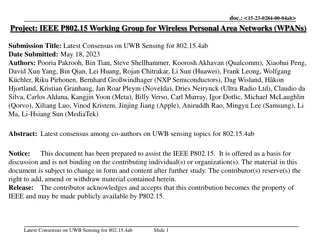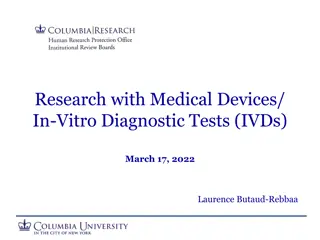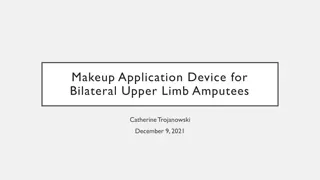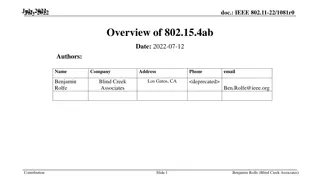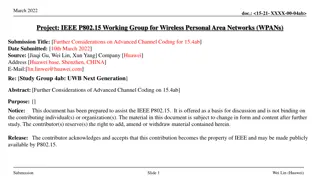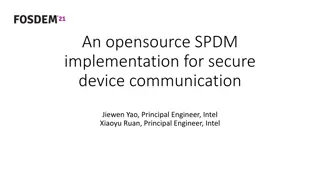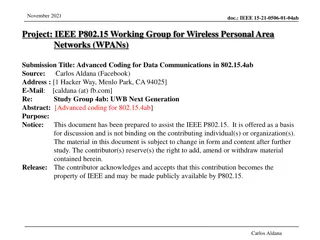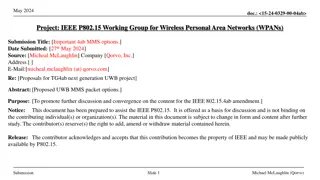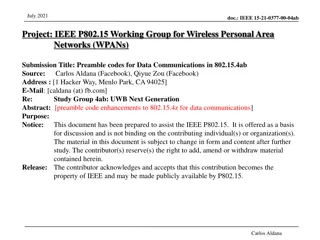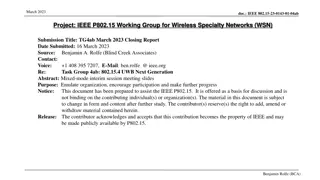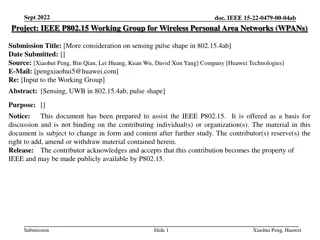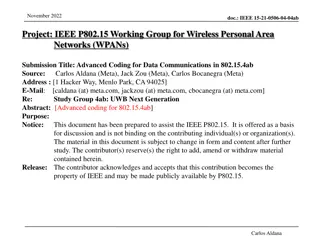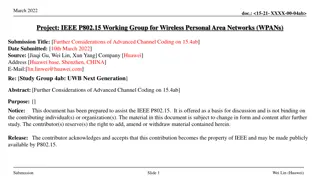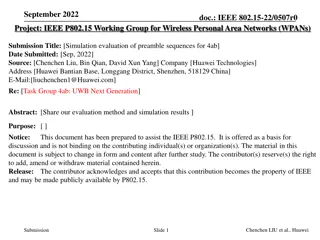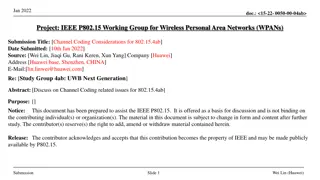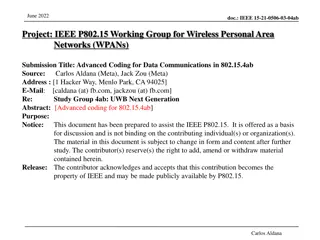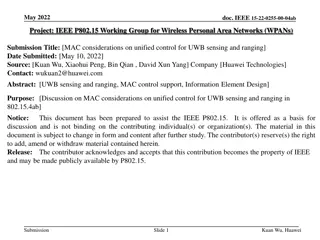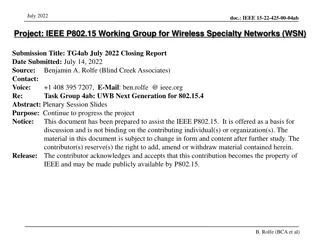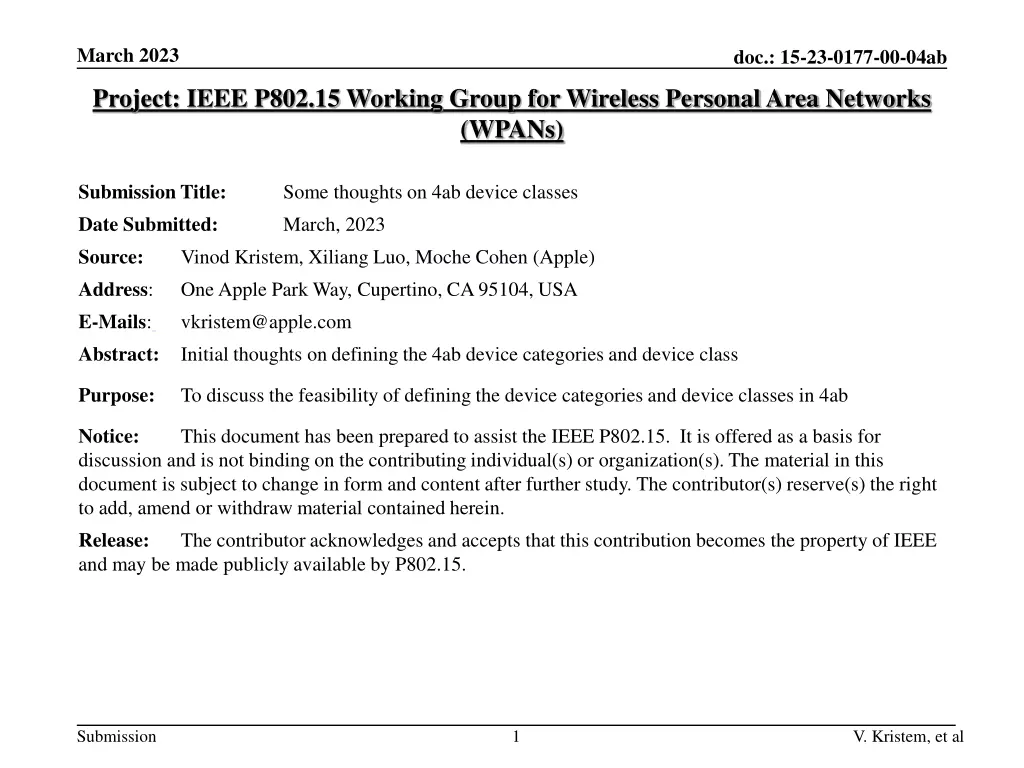
Defining 4ab Device Categories and Classes
Explore the feasibility of defining device categories and classes in 4ab, focusing on issues like interference mitigation, backward compatibility, improved link budget, and more. The document discusses various features proposed in 4ab, such as enhanced data rates, LDPC coding, dynamic PHR, enhanced ranging, sensing capabilities, and more.
Download Presentation

Please find below an Image/Link to download the presentation.
The content on the website is provided AS IS for your information and personal use only. It may not be sold, licensed, or shared on other websites without obtaining consent from the author. If you encounter any issues during the download, it is possible that the publisher has removed the file from their server.
You are allowed to download the files provided on this website for personal or commercial use, subject to the condition that they are used lawfully. All files are the property of their respective owners.
The content on the website is provided AS IS for your information and personal use only. It may not be sold, licensed, or shared on other websites without obtaining consent from the author.
E N D
Presentation Transcript
March 2023 doc.: 15-23-0177-00-04ab Project: IEEE P802.15 Working Group for Wireless Personal Area Networks (WPANs) Submission Title: Date Submitted: Source: Address: E-Mails: Abstract: Initial thoughts on defining the 4ab device categories and device class Some thoughts on 4ab device classes March, 2023 Vinod Kristem, Xiliang Luo, Moche Cohen (Apple) One Apple Park Way, Cupertino, CA 95104, USA vkristem@apple.com Purpose: To discuss the feasibility of defining the device categories and device classes in 4ab Notice: discussion and is not binding on the contributing individual(s) or organization(s). The material in this document is subject to change in form and content after further study. The contributor(s) reserve(s) the right to add, amend or withdraw material contained herein. Release: The contributor acknowledges and accepts that this contribution becomes the property of IEEE and may be made publicly available by P802.15. This document has been prepared to assist the IEEE P802.15. It is offered as a basis for Submission 1 V. Kristem, et al
March 2023 doc.: 15-23-0177-00-04ab PAR Objective Proposed Solution (how addressed) Safeguards so that the high throughput data use cases will not cause significant disruption to low duty-cycle ranging use cases Defines device categories Interference mitigation techniques to support higher density and higher traffic use cases Other coexistence improvement Defines device categories Defines device categories Backward compatibility with enhanced ranging capable devices (ERDEVs) Improved link budget and/or reduced air-time Defines device categories Defines device categories Additional channels and operating frequencies Defines device categories Improvements to accuracy / precision / reliability and interoperability for high-integrity ranging Reduced complexity and power consumption Defines device categories Defines device categories Hybrid operation with narrowband signaling to assist UWB Defines device categories Enhanced native discovery and connection setup mechanisms Defines device categories Sensing capabilities to support presence detection and environment mapping Low-power low-latency streaming Defines device categories Defines device categories Higher data-rate streaming allowing at least 50 Mbit/s of throughput Support for peer-to-peer, peer-to-multi-peer, and station-to- infrastructure protocols Infrastructure synchronization mechanisms Defines device categories Defines device categories Defines device categories Submission 2 V. Kristem, et al
March 2023 doc.: 15-23-0177-00-04ab Introduction Many new interesting features have been proposed in 4ab Enhanced Data Communications Data rates up to 124.8 Mb/s LDPC coding Dynamic PHR . Enhanced ranging with MMS NBA-MMS RSF, RIF, Mixed MMS MMRS . Sensing Sensing with Ipatov 91 codes Sensing, Sensing+Data comm Frequency stitching . 10 s of config. parameters per feature, huge parameter set!!! Single 4ab device support all of them? Submission Slide 3 V. Kristem, et al
March 2023 doc.: 15-23-0177-00-04ab Device categories in 4ab It might be good to categorize the 4ab device(s) based on the feature set 4ab Data device 4ab Sensing device 4ab Ranging device 1.95, 62.4, 124.8 Mb/s Sensing Seq Mixed MMS 4z STS MMRS 4z Data rates CIR report 4z Ipatov 4z BCC Freq. stitching NBA RSF Only MMS 4z PHR Dynamic PHR LDPC Further division into multiple classes Class A devices targeting low cost/complexity/simple extensions Class B devices targeting high performance Simplify parameter set definition, inter-operability, testing burden Vendor can target for the specific category of interest Submission Slide 4 V. Kristem, et al
March 2023 doc.: 15-23-0177-00-04ab 4ab Data device Several data enhancements introduced in 4ab High data rate modes for improved throughput 62.4 Mb/s 124.8 Mb/s Low data rate mode for improved link budget 1.95 Mb/s Advanced coding schemes for better link budget LDPC, in addition to K = 7 BCC New PHR targeting low latency streaming Dynamic PHR to support rapidly varying channel conditions Submission Slide 5 V. Kristem, et al
March 2023 doc.: 15-23-0177-00-04ab 4ab Data device classes 4ab Enhanced Data device 1.95, 62.4, 124.8 Mb/s 4z Data rates LDPC 4z Sync 4z BCC 4z PHR Dynamic PHR Enhanced Data device: lower complexity and simple extension Advanced Data device: superior performance Packet format could be defined for each device class Submission Slide 6 V. Kristem, et al
March 2023 doc.: 15-23-0177-00-04ab Summary 4ab group could look into defining device categories and the device class Simplifies parameter set definition, reduce testing burden, better UWB ecosystem 4ab Sensing device 4ab Enhanced Data device 4ab Ranging device 1.95, 62.4, 124.8 Mb/s Sensing Seq Mixed MMS 4z STS MMRS 4z Data rates CIR report 4z Ipatov 4z BCC Freq. stitching NBA RSF Only MMS 4z PHR Dynamic PHR LDPC Submission Slide 7 V. Kristem, et al

